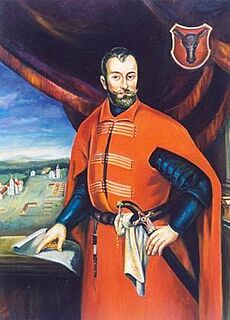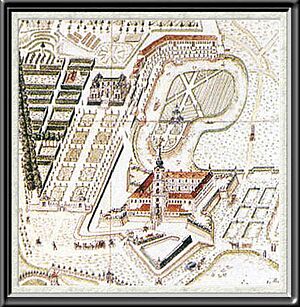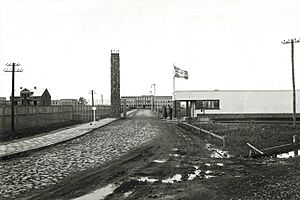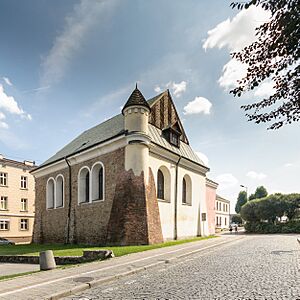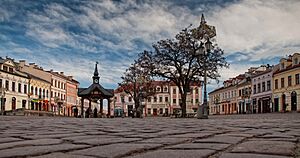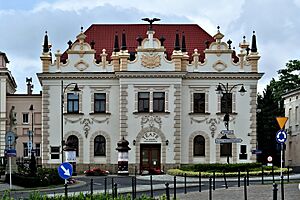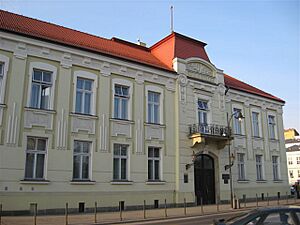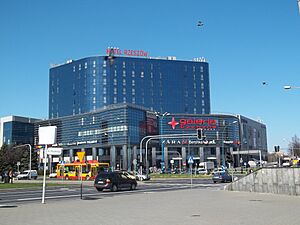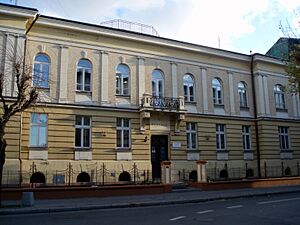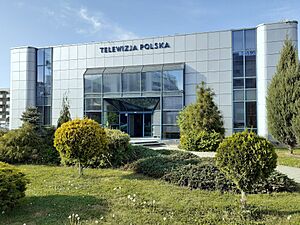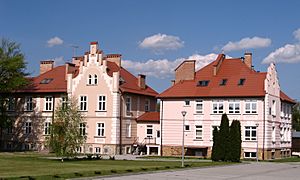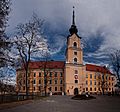Rzeszów facts for kids
Quick facts for kids
Rzeszów
|
|||||
|---|---|---|---|---|---|
|
|||||
|
|||||
| Country | |||||
| Voivodeship | |||||
| County | city county | ||||
| Town rights | 1354 | ||||
| Area | |||||
| • Total | 129 km2 (50 sq mi) | ||||
| Population
(26 April 2022)
|
|||||
| • Total | 198,609 |
||||
| • Density | 1,531/km2 (3,970/sq mi) | ||||
| Time zone | UTC+1 (CET) | ||||
| • Summer (DST) | UTC+2 (CEST) | ||||
| Postal code |
35-001 to 35–959
|
||||
| Area code(s) | +48 17 | ||||
| Car plates | RZ | ||||
| Primary airport | Rzeszów–Jasionka Airport | ||||
| Highways | |||||
| Climate | Dfb | ||||
Rzeszów is the biggest city in southeastern Poland. It sits on both sides of the Wisłok River. Rzeszów is the capital of the Subcarpathian Voivodeship. It is also the main city of Rzeszów County.
The city's story began in the Middle Ages. King Casimir III the Great gave Rzeszów city rights in 1354. Trade routes connecting Europe with the Middle East helped the city grow rich. In the 1500s, Rzeszów traded with Gdańsk and the Baltic Sea. It became a busy place for business and crafts. This was especially true under local noblemen.
After Poland was divided, Rzeszów became part of the Austrian Empire. It did not become important again until Poland became independent after World War I. Today, Rzeszów is one of Poland's top cities. It has many new businesses and a high standard of living. In 2011, Forbes magazine called Rzeszów the second most attractive city for business. The city also has many colleges and foreign consulates. Rzeszów is becoming a popular place for tourists. Its Old Town, Main Market Square, churches, and synagogues are well-preserved.
Recently, Rzeszów's population has grown a lot. This is partly because many Ukrainian refugees arrived after the Russian invasion of Ukraine. The city plans to grow even more by adding nearby areas. Rzeszów has an international airport. It is also a member of Eurocities, a network of major European cities.
Contents
History of Rzeszów
The first people lived in the Rzeszów area a very long time ago. Archaeologists found a tool from the late Stone Age here. Around 550 BC, the first farmers came to the city's area. Later, different ancient cultures lived here.
In the 600s, the first Slavs arrived. Rzeszów was likely home to the Vistulans. In the 900s, it became part of the new Polish state. Between the 1000s and 1200s, East Slavic people from Kingdom of Galicia–Volhynia took over the town.
Polish rulers took Rzeszów back in 1264. In 1340, King Casimir III the Great finally got the area back for Poland. He invited his knights to govern the land. Some say Rzeszów was called Rishof back then. The town was given Magdeburg rights. This meant its leaders could punish criminals, build defenses, and tax traders. Rzeszów had a church, a market, and a cemetery.
In 1458, Rzeszów was burned by invaders. In 1502, it was destroyed again. Earlier, in 1427, a big fire burned the town. But Rzeszów always recovered. This was because it was on important trade routes. In the 1400s, the first Jews settled in Rzeszów.
The 1500s were a good time for the town. This was especially true when Mikołaj Spytek Ligęza owned Rzeszów. He built a castle, a church, and a monastery. Rzeszów had about 2,500 people then. Its Jewish community grew quickly. The town also got royal rights to hold many markets each year. Rzeszów finally grew beyond its old medieval walls.
In 1638, Rzeszów became part of the powerful Lubomirski family's lands. At first, the town did well. In 1658, the first college opened here. It is now High School Nr 1. But then, Rzeszów faced many fires and wars. These events damaged the town.
Swedish armies captured Rzeszów during a time called The Deluge. Later, other armies also occupied the town. During the Great Northern War, the Swedes took Rzeszów again in 1702. Different armies then took turns occupying the town. They looted it and destroyed homes.
By the mid-1700s, Rzeszów's population was almost half Polish and half Jewish.
Rzeszów Under Austrian Rule
In 1772, Rzeszów became part of the Austrian Empire. It stayed under Austrian rule for 146 years. In the late 1700s, Rzeszów had 3,000 people. By the mid-1800s, the population grew to about 7,500. About 40% of them were Jewish. In 1858, the railway reached Rzeszów. This helped the town grow even more.
In 1888, the first telephone lines opened. In 1900, gas street lamps appeared. In 1911, a power plant and water system were built. The population grew to 23,000. Half of the people were Jewish. Many modern buildings were built. Most of them were in the Art Nouveau style.
During World War I, battles happened near the town. Rzeszów had a large Austro-Hungarian Army base. Russian troops captured Rzeszów on September 21, 1914. This first Russian occupation lasted only 16 days. The Austrians took it back. But the Russians returned on November 7. Rzeszów became an important center for the Imperial Russian Army. It stored a lot of food and ammunition. The Russian occupation lasted until May 1915. After the war, the Austrian government returned. But the war had damaged the town and made life harder.
Between the World Wars
On October 12, 1918, Rzeszów's mayor declared loyalty to the independent Second Polish Republic. On November 1, Rzeszów was freed after fighting German and Austrian troops. The next day, the mayor promised loyalty to the new Polish state. Around 200 Rzeszów residents died in World War I. The railway and about 60 houses were destroyed.
In 1920, Rzeszów became the capital of a county. The town grew. The creation of the Central Industrial Region greatly helped Rzeszów. It became a major center for making defense equipment. For example, PZL Rzeszów, an aircraft engine factory, opened in 1937. The Polish Army also had a large base here. In 1939, Rzeszów had 40,000 people. But its fast growth stopped when World War II began.
Second World War Events
German planes bombed Rzeszów from September 6-8, 1939. German soldiers entered Rzeszów on September 9. The Germans renamed the city Reichshof. They set up a prison and arrested many Poles. They also carried out executions.
In 1941, the Germans created a ghetto for Jewish people. The Jewish people living there were later killed in death camps.
During the war, Rzeszów was a key center for the Polish Underground State. In the summer of 1944, Polish resistance fighters attacked German positions. On August 2, Rzeszów was taken by the Polish Home Army.
Polish leaders tried to talk with the Soviets, but it didn't work. The Soviet secret police (NKVD) opened a prison in Rzeszów Castle. They sent many Home Army soldiers there. In October 1944, a Home Army group tried to free 400 prisoners from the castle. The attack failed.
The Holocaust in Rzeszów
Before World War II, about 14,000 Jews lived in Rzeszów. This was more than one-third of the city's population. German soldiers occupied the town on September 10, 1939. They began to persecute the Jews right away. By the end of 1939, there were 10 forced labor camps in the Rzeszów area. Many Jews were forced to work as slave laborers. Jews were also forced to live in a ghetto.
Life in the ghetto was very hard. Hundreds of people died from hunger and sickness. During the war, about 20,000 Jews were killed in the Rzeszów ghetto.
Only about 100 of Rzeszów's 14,000 Jews survived the war. Some hid in Poland, others were in camps. The secret Polish Council to Aid Jews helped Jews in the region. Some Poles were arrested or killed for helping Jews. After the war, about 600 more Rzeszów Jews returned from the Soviet Union. Almost all of them later left Rzeszów and Poland.
After World War II
On July 7, 1945, Rzeszów became the capital of a new region called Rzeszów Voivodeship. This helped the city grow quickly. New government offices were built. In 1951, several nearby villages became part of Rzeszów. The city's area grew to 39 square kilometers.
In the early 1980s, Rzeszów was a main center for farmer protests. Farmers occupied local offices for 50 days. This led to an agreement that helped create the Rural Solidarity.
On January 1, 1999, Rzeszów became the capital of Podkarpackie Voivodeship. Its population grew to 170,000. The city's area reached over 91 square kilometers.
In 2004, Rzeszów hosted the Central European Olympiad in Informatics (CEOI). This is a competition for young computer scientists.
From 2017 to 2021, Rzeszów's city limits grew even more. It added several villages. The city's area increased to over 120 square kilometers. Its population grew to more than 188,000 people.
In 2022, after the Russian invasion of Ukraine, Rzeszów became a key hub. It helped move military supplies to Ukraine from many countries. In June 2022, Rzeszów became a sister city with Chernihiv, Ukraine.
Papal Visit to Rzeszów
In 1991, Pope John Paul II visited Rzeszów. Nearly 1,000,000 people came to the celebrations. The Pope honored Bishop Józef Sebastian Pelczar. On March 25, 1992, Pope John Paul II created the new Diocese of Rzeszów. The city's Church of the Sacred Heart became the new city cathedral.
Geography and Climate
Rzeszów is in the north temperate zone. It has a continental climate with four clear seasons. Summers are hot, and winters are cold and snowy.
Average summer temperatures are about 18 to 19.6 °C (64 to 67 °F). Winter temperatures range from −2.1 to 0 °C (28 to 32 °F). The average yearly temperature is 8.9 °C (48 °F).
In summer, temperatures often go above 25 °C (77 °F). Sometimes they even reach 30 °C (86 °F). In winter, the temperature drops to −5 °C (23 °F) at night. It is about 0 °C (32 °F) during the day. On very cold nights, it can drop to −15 °C (5 °F). Rzeszów is near the Carpathian Mountains. Sometimes, a special wind called halny blows. This wind can make the temperature rise very quickly.
| Climate data for Rzeszów (Jasionka) 1991–2020 normals, extremes 1952–present | |||||||||||||
|---|---|---|---|---|---|---|---|---|---|---|---|---|---|
| Month | Jan | Feb | Mar | Apr | May | Jun | Jul | Aug | Sep | Oct | Nov | Dec | Year |
| Record high °C (°F) | 12.7 (54.9) |
17.2 (63.0) |
23.8 (74.8) |
29.1 (84.4) |
33.0 (91.4) |
34.8 (94.6) |
35.6 (96.1) |
36.5 (97.7) |
36.0 (96.8) |
25.6 (78.1) |
21.3 (70.3) |
16.5 (61.7) |
36.5 (97.7) |
| Mean maximum °C (°F) | 8.0 (46.4) |
10.9 (51.6) |
17.1 (62.8) |
23.9 (75.0) |
27.5 (81.5) |
30.5 (86.9) |
32.1 (89.8) |
32.0 (89.6) |
27.2 (81.0) |
22.3 (72.1) |
16.2 (61.2) |
9.3 (48.7) |
33.1 (91.6) |
| Mean daily maximum °C (°F) | 0.8 (33.4) |
2.7 (36.9) |
7.9 (46.2) |
15.0 (59.0) |
20.1 (68.2) |
23.5 (74.3) |
25.6 (78.1) |
25.2 (77.4) |
19.6 (67.3) |
13.6 (56.5) |
7.4 (45.3) |
2.1 (35.8) |
13.6 (56.5) |
| Daily mean °C (°F) | −1.9 (28.6) |
−0.6 (30.9) |
3.3 (37.9) |
9.1 (48.4) |
14.0 (57.2) |
17.6 (63.7) |
19.4 (66.9) |
18.9 (66.0) |
13.9 (57.0) |
8.9 (48.0) |
4.1 (39.4) |
−0.5 (31.1) |
8.9 (48.0) |
| Mean daily minimum °C (°F) | −4.7 (23.5) |
−3.9 (25.0) |
−0.8 (30.6) |
3.4 (38.1) |
8.2 (46.8) |
11.9 (53.4) |
13.5 (56.3) |
13.0 (55.4) |
8.9 (48.0) |
4.8 (40.6) |
1.2 (34.2) |
−3.0 (26.6) |
4.4 (39.9) |
| Mean minimum °C (°F) | −17.5 (0.5) |
−15.4 (4.3) |
−9.3 (15.3) |
−3.8 (25.2) |
0.8 (33.4) |
5.9 (42.6) |
7.9 (46.2) |
6.7 (44.1) |
1.3 (34.3) |
−3.6 (25.5) |
−7.7 (18.1) |
−13.8 (7.2) |
−20.3 (−4.5) |
| Record low °C (°F) | −33.6 (−28.5) |
−35.8 (−32.4) |
−30.9 (−23.6) |
−10.0 (14.0) |
−4.6 (23.7) |
−0.9 (30.4) |
3.7 (38.7) |
0.9 (33.6) |
−5.3 (22.5) |
−11.4 (11.5) |
−21.0 (−5.8) |
−29.8 (−21.6) |
−35.8 (−32.4) |
| Average precipitation mm (inches) | 33.4 (1.31) |
32.3 (1.27) |
39.0 (1.54) |
45.9 (1.81) |
79.3 (3.12) |
81.6 (3.21) |
90.8 (3.57) |
63.5 (2.50) |
66.0 (2.60) |
49.6 (1.95) |
36.1 (1.42) |
34.4 (1.35) |
651.8 (25.66) |
| Average extreme snow depth cm (inches) | 8.2 (3.2) |
8.8 (3.5) |
5.4 (2.1) |
1.5 (0.6) |
0.0 (0.0) |
0.0 (0.0) |
0.0 (0.0) |
0.0 (0.0) |
0.0 (0.0) |
0.5 (0.2) |
3.1 (1.2) |
4.4 (1.7) |
8.8 (3.5) |
| Average precipitation days (≥ 0.1 mm) | 16.23 | 14.61 | 13.90 | 12.43 | 14.07 | 13.20 | 14.23 | 11.23 | 11.10 | 12.07 | 13.47 | 15.40 | 161.94 |
| Average snowy days (≥ 0 cm) | 18.0 | 16.2 | 6.8 | 0.8 | 0.0 | 0.0 | 0.0 | 0.0 | 0.0 | 0.4 | 4.6 | 12.0 | 58.8 |
| Average relative humidity (%) | 85.2 | 82.4 | 76.5 | 70.8 | 73.6 | 74.4 | 74.4 | 75.0 | 80.4 | 83.0 | 86.3 | 86.5 | 79.0 |
| Mean monthly sunshine hours | 48.9 | 67.1 | 124.1 | 177.8 | 231.0 | 232.4 | 245.9 | 240.7 | 163.5 | 117.3 | 55.4 | 38.6 | 1,742.8 |
| Source 1: Institute of Meteorology and Water Management | |||||||||||||
| Source 2: Meteomodel.pl (records, relative humidity 1991–2020) | |||||||||||||
Main Sights to See
- The Main Square
- Rzeszów Town Hall: Built in 1591, later updated in Neogothic and Renaissance Revival styles.
- Saint Adalbert and Saint Stanislaus Church: A Gothic-style church from the 1400s.
- Basilica of the Assumption of the Blessed Virgin Mary: A Baroque church from the 1600s, part of a Bernardine monastery.
- Regional Museum: Located in a former Piarists monastery from the 1600s.
- Old Town (1600s) and New Town (1700s) Synagogues: Restored between 1954 and 1963.
- Rzeszów Castle: Rebuilt in the 1600s.
- Lubomirski Summer Palace: Rebuilt in the 1700s in Rococo style.
- Wanda Siemaszkowa Theatre: Used to be Sokol houses, built from 1890-1900.
- PKO Bank Building: Built from 1906–07 in Renaissance Revival style.
- Rzeszów Court of Appeals: A Socialist realist building.
- Subcarpathian Philharmonic: A Modernist building.
- Monument to The Revolutionary Action: Built in 1974.
- Olszynki Park: A tall skyscraper that is still being built.
- Podziemia: Underground Tunnels.
Population and Demographics
According to data from June 30, 2020, Rzeszów had 196,821 people. Unlike some other Polish cities of its size, Rzeszów's population is growing.
Rzeszów is the 17th largest city in Poland by population. It is the 20th largest city by area.
| Historical population | |||||||||||||||||||||||||||||||||||||||||||
|---|---|---|---|---|---|---|---|---|---|---|---|---|---|---|---|---|---|---|---|---|---|---|---|---|---|---|---|---|---|---|---|---|---|---|---|---|---|---|---|---|---|---|---|
|
|
||||||||||||||||||||||||||||||||||||||||||
| source | |||||||||||||||||||||||||||||||||||||||||||
Culture and Arts
Theatres in Rzeszów
- Wanda Siemaszkowa Theatre (started in 1944)
- Maska Theatre
- Rzeszów Dance Theatre
Museums to Visit
- Ethnographic Museum
- Museum of the City of Rzeszów
- Diocesan Museum
- Rzeszów Castle Museum
Art Galleries
- "Szajna" gallery
- "Pod Ratuszem" gallery
- "z Podwórza" gallery
- OPe Photo Gallery
Libraries for Learning
- Provincial and City Public Library in Rzeszów
- Rzeszów University Library
- Rzeszów University of Technology Library
Other Cultural Venues
- Podpromie Hall
- Artur Malawski Philharmonic Hall
Sports in Rzeszów

| Club | Sport | League | Trophies |
|---|---|---|---|
| Resovia | Men's volleyball | PlusLiga | 7 Polish Championships 3 Polish Cups 1 CEV Cup (2024) |
| Stal Rzeszów | Speedway | I liga | 2 Polish Championships (1960, 1961) |
| Resovia | Men's football | I liga | 0 |
| Stal Rzeszów | Men's football | I liga | 1 Polish Cup (1975) |
Economy and Infrastructure
Industry and Business
- Asseco Poland SA: The biggest computer software company in Poland.
- Eastern IT Cluster: A group of IT companies based in Rzeszów.
- FIBRAIN: Makes ICT systems.
- G2A.COM Limited: A global online marketplace for gaming products.
- Goodrich Corporation: Opened a 5.3-hectare (13-acre) factory near Rzeszów in 2010.
- Novartis International AG: Has Gerber Products Company food production facilities in Rzeszów.
- Sanofi-Aventis: A large pharmaceutical company.
- United Technologies Corporation (Pratt & Whitney division): Makes aerospace parts. It is one of only two places in the world that makes F-16 engines.
- Valeant Pharmaceuticals International Rzeszów.
- Zelmer SA: Makes household equipment.
Near Rzeszów, there is a special power line. It is the only 750 kV power line in Poland.
Media and Communication
Radio Stations
- Radio Rzeszów
- Radio Eska Rzeszów
- Akademickie Radio Centrum
- Katolickie Radio Via
- Radio RES
Newspapers
- Gazeta Codzienna NOWINY
- Super Nowości
- Nasz Dom
- Gazeta Wyborcza Rzeszów
Television
- Polish Television (TVP) branch in Rzeszów
- Rzeszów municipal television
Internet News
- Rzeszow-Info.pl
Transportation in Rzeszów
Roads and Highways
Rzeszów is on the main ![]() West-East European E40 Highway. This highway goes through many countries. In Poland, the E40 follows the
West-East European E40 Highway. This highway goes through many countries. In Poland, the E40 follows the ![]() A4 Highway. The
A4 Highway. The ![]() S19 Expressway connects Rzeszów to Belarus and Slovakia. This is part of the planned Via Carpathia route.
S19 Expressway connects Rzeszów to Belarus and Slovakia. This is part of the planned Via Carpathia route.
City roads have been improved recently. A smart traffic system called SCATS helps manage traffic. The A4 highway and S19 expressway go around the city.
Airport Services
Rzeszów-Jasionka Airport is about 10 kilometres (6.2 miles) north of the city. Airlines like Ryanair, LOT Polish Airlines, and Lufthansa offer regular flights. There are also seasonal flights to popular vacation spots.
Bus Network
The city has 49 bus lines. These include night buses and airport buses. Rzeszów is also a starting point for trips to the Bieszczady Mountains. Many buses go to Sanok.
Railways and Trains
Rzeszów is an important train hub. It is on the main west–east rail route, Line 91. This line goes from Silesia and Kraków to the Polish eastern border. It then continues into Ukraine. Rzeszów has a main railway station. There are also five other stations in the city. Two other train lines go from Rzeszów to Jasło and Tarnobrzeg.
Education in Rzeszów
Universities and Colleges
- Rzeszów University: Started in 2001 by combining smaller schools.
- Rzeszów University of Technology: Became a university in 1974.
- University of Information Technology and Management in Rzeszów: Started in 1996.
- It has branches in Dębica, Krosno, and Nisko.
- Wyższa Szkoła Zarządzania
- WSPiA Rzeszów School of Higher Education: Started in 1995.
Important High Schools
- Konarski's Number 1 High School in Rzeszów
- John Paul II High School
International Connections
Consulates in Rzeszów
Rzeszów has honorary consulates for the Czech Republic, Germany, Hungary, and Slovakia.
Sister Cities Around the World
Rzeszów is connected with these sister cities:
 Bielefeld, Germany
Bielefeld, Germany Buffalo, United States
Buffalo, United States Chernihiv, Ukraine
Chernihiv, Ukraine Fangchenggang, China
Fangchenggang, China Gainesville, United States
Gainesville, United States Ivano-Frankivsk, Ukraine
Ivano-Frankivsk, Ukraine Klagenfurt, Austria
Klagenfurt, Austria Košice, Slovakia
Košice, Slovakia Lamia, Greece
Lamia, Greece Lutsk, Ukraine
Lutsk, Ukraine Lviv, Ukraine
Lviv, Ukraine Nyíregyháza, Hungary
Nyíregyháza, Hungary Rushmoor, England, United Kingdom
Rushmoor, England, United Kingdom Satu Mare, Romania
Satu Mare, Romania Split, Croatia
Split, Croatia Truskavets, Ukraine
Truskavets, Ukraine
Famous People from Rzeszów

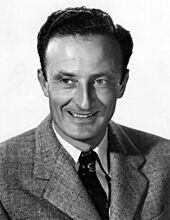
- Maurycy Allerhand (1868–1942), a lawyer
- Stan Borys (born 1941), a singer
- Aleksander Cichoń (born 1958), a wrestler
- Lukasz Cieplinski (1913–1951), a hero of the resistance
- Jan Domarski (born 1946), a footballer
- Tadeusz Ferenc (1940-2022), a politician
- Jerzy Grotowski (1933–1999), a theatre director
- Rafał Jonkisz (born 1997), a male model
- Dawid Kostecki (1981–2019), a boxer
- Paweł Kowal (born 1975), a politician
- Dawid Lampart (born 1990), a motorcycle speedway rider
- Joanna Lech (born 1984), a poet
- Hieronim Augustyn Lubomirski (1648–1706), a nobleman and military leader
- Stanisław Herakliusz Lubomirski (1642–1702), a nobleman and politician
- Łukasz Różański (born 1986), a professional boxer
- Anja Rubik (born 1983), a supermodel
- Władysław Sikorski (1881–1943), a military and political leader
- Mieczysław Boruta-Spiechowicz (1894–1985), a military officer
- Tomasz Stańko (1942–2018), a jazz musician and composer
- Justyna Steczkowska (born 1972), a singer and songwriter
- Józef Szajna (1922–2008), a set designer and painter
- Rich Szaro (1948–2015), a Polish-born American football player
- Andrzej Szlachta (born 1947), a politician
- Józef Zając (1891–1963), a general and pilot
- Oscar Zehngut (born 1874), a violinist
- Fred Zinnemann (1907–1997), a film director
Images for kids
See also
 In Spanish: Rzeszów para niños
In Spanish: Rzeszów para niños












